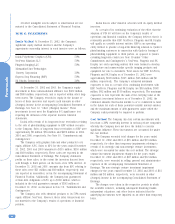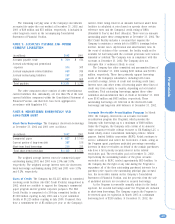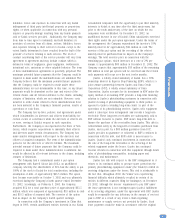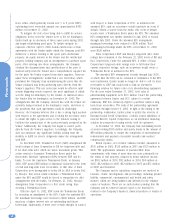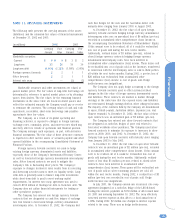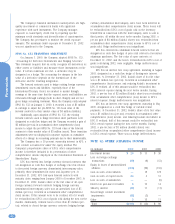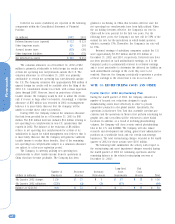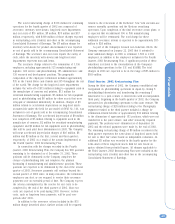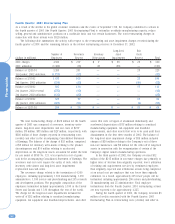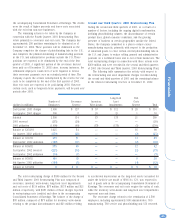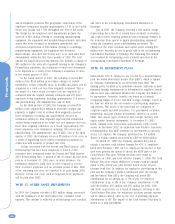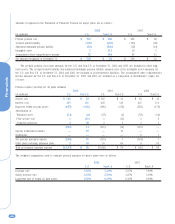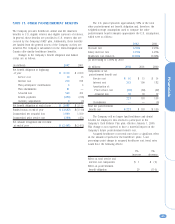Kodak 2002 Annual Report Download - page 60
Download and view the complete annual report
Please find page 60 of the 2002 Kodak annual report below. You can navigate through the pages in the report by either clicking on the pages listed below, or by using the keyword search tool below to find specific information within the annual report.
Financials
60
The Company’s financial instrument counterparties are high-
quality investment or commercial banks with significant
experience with such instruments. The Company manages
exposure to counterparty credit risk by requiring specific
minimum credit standards and diversification of counterparties.
The Company has procedures to monitor the credit exposure
amounts. The maximum credit exposure at December 31, 2002
was not significant to the Company.
SFAS No. 133 TRANSITION ADJUSTMENT
On January 1, 2000, the Company adopted SFAS No. 133,
“Accounting for Derivative Instruments and Hedging Activities.”
This statement requires that an entity recognize all derivatives as
either assets or liabilities and measure those instruments at fair
value. If certain conditions are met, a derivative may be
designated as a hedge. The accounting for changes in the fair
value of a derivative depends on the intended use of the
derivative and the resulting designation.
The forward contracts used to hedge existing foreign currency
denominated assets and liabilities, especially those of the
International Treasury Center, are marked to market through
earnings at the same time that the exposed assets and liabilities are
remeasured through earnings (both in other charges) and are not
given hedge accounting treatment. When the Company early-adopted
SFAS No. 133 on January 1, 2000, it recorded a loss of $1 million
in earnings to adjust the pre-SFAS No. 133 book value of the
forward contracts to their market value of $4 million (liability).
Additionally, upon adoption of SFAS No. 133, the existing
forward contracts used to hedge forecasted silver purchases were
designated as cash flow hedges and the Company recorded a gain of
$3 million (pre-tax) in accumulated other comprehensive (loss)
income to adjust the pre-SFAS No. 133 book value of the forward
contracts to their market value of $3 million (asset). These transition
adjustments were not displayed in separate captions as cumulative
effects of a change in accounting principle due to their immateriality.
The Company has a 50 percent ownership interest in KPG, a
joint venture accounted for under the equity method. The
Company’s proportionate share of KPG’s other comprehensive
income is therefore included in its presentation of other
comprehensive income displayed in the Consolidated Statement of
Shareholders’ Equity.
KPG has entered into foreign currency forward contracts that
are designated as cash flow hedges of exchange rate risk related
to forecasted foreign currency denominated intercompany sales,
primarily those denominated in euros and Japanese yen. At
December 31, 2002, KPG had open forward contracts with
maturity dates ranging from January 2003 to December 2003. At
December 31, 2002, Kodak’s share of the fair value of all open
foreign currency forward contracts hedging foreign currency
denominated intercompany sales was an unrealized loss of $5
million (pre-tax), recorded in accumulated other comprehensive
(loss) income. If this amount were to be realized, all of it would
be reclassified into KPG’s cost of goods sold during the next twelve
months. Additionally, realized losses of less than $1 million (pre-
tax), related to closed foreign currency contracts hedging foreign
currency denominated intercompany sales, have been deferred in
accumulated other comprehensive (loss) income. These losses will
be reclassified into KPG’s cost of goods sold as the inventory
transferred in connection with the intercompany sales is sold to
third parties, all within the next twelve months. During 2002, a
pre-tax gain of $4 million (Kodak’s share) was reclassified from
accumulated other comprehensive (loss) income to KPG’s cost of
goods sold. Hedge ineffectiveness was insignificant.
KPG has entered into aluminum forward contracts that are
designated as cash flow hedges of price risk related to forecasted
aluminum purchases. The fair value of open contracts at
December 31, 2002, and the losses reclassified into KPG’s cost of
goods sold during 2002, were negligible. Hedge ineffectiveness
was insignificant.
KPG has an interest rate swap agreement, maturing in August
2003, designated as a cash flow hedge of floating-rate interest
payments. At December 31, 2002, Kodak’s share of its fair value
was a $1 million loss (pre-tax), recorded in accumulated other
comprehensive (loss) income, and reducing Kodak’s investment in
KPG. If realized, all of this amount would be reclassified into
KPG’s interest expense during the next twelve months. During
2002, a pre-tax loss of $2 million (Kodak’s share) was reclassified
from accumulated other comprehensive (loss) income to KPG’s
interest expense. Hedge ineffectiveness was insignificant.
KPG has an interest rate swap agreement, maturing in May
2005, designated as a cash flow hedge of variable rental
payments. At December 31, 2002, Kodak’s share of its fair value
was a $1 million loss (pre-tax), recorded in accumulated other
comprehensive (loss) income, and reducing Kodak’s investment in
KPG. If realized, half of this amount would be reclassified into
KPG’s rental expense during the next twelve months. During
2002, a pre-tax loss of $1 million (Kodak’s share) was
reclassified from accumulated other comprehensive (loss) income
to KPG’s rental expense. There was no hedge ineffectiveness.
NOTE 12: OTHER (CHARGES) INCOME
(in millions) 2002 2001 2000
Investment income $20 $15 $36
Loss on foreign exchange
transactions (19) (9) (13)
Equity in losses of unconsolidated
affiliates (106) (79) (110)
Gain on sales of investments —18 127
Gain on sales of capital assets 24 351
Loss on sales of subsidiaries —— (9)
Interest on past-due receivables 610 14
Minority interest (17) 11 (11)
Non-strategic venture investment
impairments (18) (3) —
Other 916 11
Total $(101) $ (18) $ 96




